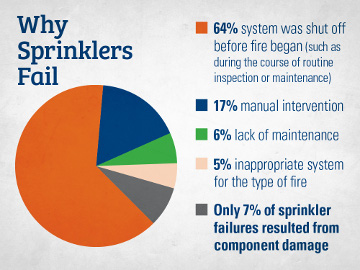- Home
- Loss Control
- Loss Control Insights
- 3 C's for Safer Sprinkler Systems
Out of sight, out of mind is risky when it comes to sprinkler systems, says EMC Risk Improvement Engineer Kody Daniel. Because sprinklers are silently at the ready in case of an emergency, it’s easy to forget that they need regular TLC. And because there are different types of sprinklers with many interrelated parts, it’s important to understand your system and recognize the components and practices that ensure it will properly protect your building.
Kody shares some basic (and important) points with these 3 C’s for keeping sprinkler systems safe, primed and ready for action:
1. Check your system regularly and schedule weekly, monthly, quarterly and annual inspections.
“You need to be proactive in performing checks and maintaining your system,” Kody says. “As we work with organizations, we’ve noticed cases where two or three years have gone by since the system and fire extinguishers were last tested, putting the company at risk.” He notes that 6% of sprinkler system failures are due to a lack of maintenance. Because there are many components to check, including valves, alarms, gauges, labels, connections, drains, pumps, piping, hangers and bracing, as well as the actual sprinklers, having a written document to work from is the best way to stay on top of essential testing.To set up a maintenance routine, Kody recommends using the EMC sprinkler maintenance template as the basis to developing your own program.
2. Control your control valves.
While losing track of time and missing routine testing is the biggest problem Kody sees, a second common oversight is in safeguarding control valves. National Fire Protection Association standards (NFPA 25, Inspection, Testing and Maintenance of Water-Based Fire Protection Systems) require that each control valve of an automatic fire sprinkler system be secured. This can be done with a chain and lock, a locked and limited access room or a tamper switch. Kody recommends using at least two of these safeguards. For more information about control valves and securing them, refer to EMC Fact Sheet on Control Valve Safeguarding.3. Call on others for assistance.
Beyond testing and safeguarding, Kody admits that sprinkler systems can be complex with multiple types (wet, dry, pre-action and deluge), a number of components (tamper switches, flow alarms, gauges, hydraulic posting design info, sprinkler heads and more) and the necessity for your system layout to fit your building and operations. You’ll need to work closely with reputable sprinkler companies to explore and choose the best options for your company, then educate yourself and your employees on the system components.Kody suggests additional resources found on the fire prevention topic page. You’ll find information on alarms, labeling, storage practices, pump testing, pump maintenance and more.
EMC experts can actively assist in several ways, including helping with fire pump testing and evaluating the adequacy of your fire sprinkler system in your current building or when planning to remodel or move to a new location. For answers to your questions and more information on how an EMC loss control representative can assist you, email losscontrol@emcins.com.
Get in touch
Need help? We’re here for you! Whether you have questions or need personalized assistance, your local office is ready to support you.
Loss Control Insights
Stay informed with the latest news and receive actionable safety tips, all carefully curated by our team of experts.
